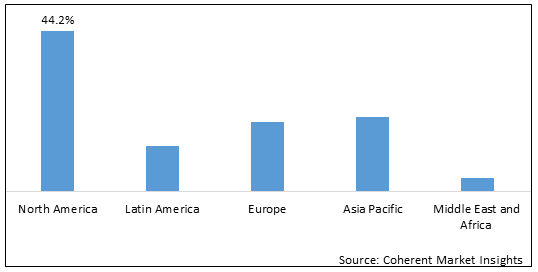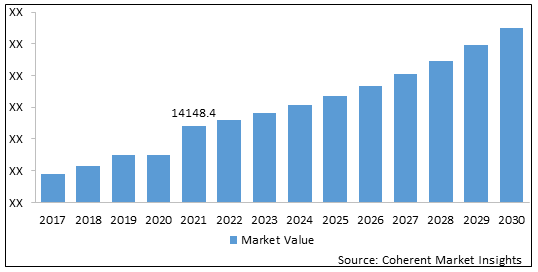
Gesture is non-verbal way of communicating a specific message. Gesture recognition is a commuting user interface that allows computers to capture and interpret human commands and gestures. It refers to the ability of a computer to understand human gestures and execute commands based on gestures. Gesture recognition involves various methods such as facial recognition, voice recognition, IRIS recognition, eye movement, leg movement, and others. Gesture recognition is an alternative user interface to provide real-time data to the computer system. Gesture recognition technology is used in industries such as automotive, healthcare, gaming, consumer electronics, and others. Technological advancements in gesture recognition along with the need to deliver remote less gesture presentation in organizations is expected to provide lucrative opportunities for the growth of the global gesture recognition market.
The Global Gesture Recognition Market was valued at US$ 14148.4 Mn in 2021.
Recent Developments:
Gesture Recognition Market Report Coverage
| Report Coverage | Details | ||
|---|---|---|---|
| Base Year: | 2021 | Market Size in 2021: | US$ 14148.4 Mn |
| Historical Data for: | 2017 to 2020 | Forecast Period: | 2022 to 2030 |
| Forecast Period 2022 to 2030 CAGR: | 23.6% | 2030 Value Projection: | US$ 93773.2 Mn |
| Geographies covered: |
|
||
| Segments covered: |
|
||
| Companies covered: |
Intel Corporation, Qualcomm Technologies, Inc., IBM Corporation, Google Inc., Microsoft, Facebook, Inc., Samsung Electronics Co., Ltd., Baidu Inc., Cisco Systems, Inc., Apple, Inc., Infineon Technologies AG, PointGrab Inc., Elliptic Laboratories A/S, Microchip Technology Inc., OmniVision Technologies, Inc., OMRON Corporation, Sony Corporation, Texas Instruments Incorporated, Sony Depthsensing Solutions, Jabil Inc., and Ultraleap. |
||
| Growth Drivers: |
|
||
| Restraints & Challenges: |
|
||
Uncover macros and micros vetted on 75+ parameters: Get instant access to report
Restraint:
Integration of gesture technology is difficult due to lack of technology
Global Gesture Recognition Market - Impact of Coronavirus (Covid-19) Pandemic:
Due to the COVID-19 pandemic, several industries have witnessed a significant shift in their businesses. But it had a positive impact on the growth of the global gesture recognition market as the aviation sector was moving towards biometric onboarding.
The implementation of new technology solutions such as facial recognition and biometrics was already in progress at the airport and after COVID-19 implementation of these technologies happening at a faster pace. These new technologies helped to contain the spread of coronavirus and also helped in speeding up the onboarding process. For instance, in September 2020, Spirit Airlines, Inc., a U.S.-based airline company launched biometric facial recognition for passenger check-ins at Chicago O’Hare and New York LaGuardia airports.
North America held a dominant position in the global gesture recognition market in 2021
Statistics:
North America region dominated the global gesture recognition market in 2021, accounting for a 44.2% share in terms of value, followed by Europe, Asia Pacific, and Latin America, respectively
Figure 1: Global Gesture Recognition Market Share (%), By Region, 2021

To learn more about this report, Download Free Sample
North America global gesture recognition market is expected to be one of the prominent region in the global market witness high growth during the forecast period. This is owing increasing demand for gesture recognition in emerging economies such as U.S. and Canada.
Figure 2: Global Gesture Recognition Market (US$ Mn) Analysis and Forecast, 2022 - 2030

To learn more about this report, Download Free Sample
The global gesture recognition market was valued at US$ 14148.4 Mn in 2021 and is expected to reach US$ 93773.2 Mn by 2030, growing at a CAGR of 23.6% between 2022 and 2030.
Major players operating in the global gesture recognition market include Intel Corporation, Qualcomm Technologies, Inc., IBM Corporation, Google Inc., Microsoft, Facebook, Inc., Samsung Electronics Co., Ltd., Baidu Inc., Cisco Systems, Inc., Apple, Inc., Infineon Technologies AG, PointGrab Inc., Elliptic Laboratories A/S, Microchip Technology Inc., OmniVision Technologies, Inc., OMRON Corporation, Sony Corporation, Texas Instruments Incorporated, Sony Depthsensing Solutions, Jabil Inc., and Ultraleap.
Share
Share
About Author
Monica Shevgan has 9+ years of experience in market research and business consulting driving client-centric product delivery of the Information and Communication Technology (ICT) team, enhancing client experiences, and shaping business strategy for optimal outcomes. Passionate about client success.
Missing comfort of reading report in your local language? Find your preferred language :
Transform your Strategy with Exclusive Trending Reports :
Frequently Asked Questions
Select a License Type
Joining thousands of companies around the world committed to making the Excellent Business Solutions.
View All Our Clients